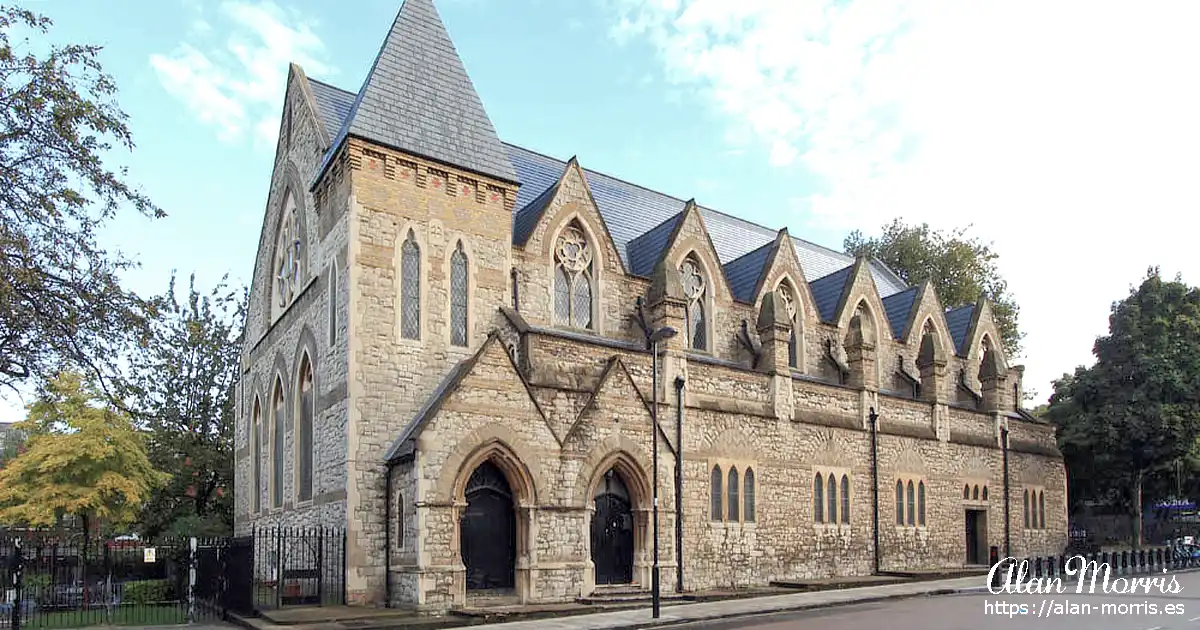The founder of St Silas church in Pentonville was Father A. L. Courteney, Vicar of Saint James, Pentonville. Saint Silas was carved out of his parish. Father Courtenay bought land, previously the site of a brewery, at the junction of Risinghill Street and Penton Street.
History of St Silas Church.
A temporary iron church was erected, presumably made out of corrugated iron. S.S.Teulon designed the stone church, which replaced the chapel and the foundation stone was laid on 19th July 1860. Father Courteney, however, had difficulties in the construction of the new church, and one particular wall at the east end had to be demolished. Being too near to the road, it was rebuilt further back. He later sued both the architect and the builder for using Kentish Rag stone, a soft stone which crumbles easily after exposure to the elements.
E.P. Loftus Brock eventually completed the church. It was altered considerably from the original design, as can be seen by looking at the cloisters, where corbels supporting non-existent galleries or beams can be seen protruding from the walls, supporting nothing. The final plan was very much more straightforward than Father Courtney's original plan.
The church was opened in April 1863 and was dedicated as Christ Church. This dedication was altered to Saint Silas at the consecration on 16th July 1867. Saint Silas is an uncommon dedication, with only one other church in the diocese of London having the same dedication, Saint Silas the Martyr, Kentish Town.
The walls of the church are faced with Kentish Rag stone and a mixture of brick. The nave is wide and tends to take the visitor by surprise, mainly as the exterior gives the impression of a much smaller building. Along either side of the building, there are passage aisles. The attractive clerestory windows are all under gabled roofs, each one different in design and pattern.
The roof has always attracted architects because of its peculiarity of having two long wall posts per pier, which support twin tie beams at a low level.
The Martin Travers baroque altar to Our Lady of Walsingham is the gift of the American gin distiller, Mr F. Russell Brown, whose family originated in the local area.
There is a west gallery containing a delicate organ that came to the church from the redundant church of Saint Thomas, Regent Street, aka Archbishop Tenison's Chapel, Kingly Street. In 1884, William White added a chancel.
The interior of the church is cream-white. The High Altar has a stone marble top and a slate base. The High Altar contains the authenticated relics of S. Vincent (martyr) and S. Victorinus (martyr).
When the church was first built, it was not associated with the catholic revival. However, on White Lion Street, a mission was set up by the parish of All Saints Margaret Street, a church that, at that time, had played a part in the 'Oxford Movement' in the West End of London.
The Mission Church, under the patronage of All Saints, came to stand for a very much more robust and full-blooded Catholicism. Saint Silas church and the mission church became linked together under one administration.
Where Father Preedy had taught the fundamentals of the catholic faith, along with boxing and football, Father Archer added the Papalist extras such as devotion to the Sacred Heart of Jesus and Our Lady, so that Saint Silas and All Saints Mission became as famous, or rather infamous, as the church of Saint Saviour, Hoxton, for what was described as extreme Catholicism.
In Father Archer's incumbency, Low Mass was frequently said in Latin. Benediction and Exposition of the Blessed Sacrament brought the church into line with the devotional practices of the rest of Western Catholic Christendom. The Children of Mary would meet week by week to say the Rosary together. Marian processions in May were the order of the day and were well supported by girls wearing white veils.
Immediately after high mass on Sundays in those days, a Latin Mass was held for lapsed Catholics. Indulgences were to be earned by reciting specific prayers and even by going through particular doors. There was nothing to distinguish Saint Silas, Pentonville, from those churches which were under the jurisdiction of the Cardinal Archbishop of Westminster. The people responded to it and loved it.
The church interior still reflects the Catholic way of practising the Christian faith. The shrines are still here, as are the candles which burn before them. The Pieta, or Our Lady of Pity, is a memorial to those who died in the wars.
The chapel of All Saints at the back of the Church is the old high altar and triptych taken from the mission when it closed. It is slightly Art Nouveau in style.
Who was Saint Silas?
He was one of the companions of Saint Paul and is mentioned in the Acts of the Apostles. He is sometimes referred to as Silvanus (from the Greek word meaning wood). He is mentioned as an elder of the Church in Acts15:22. He may have been a Jew and was afforded the rights of a Roman citizen (Acts 16:37). Some of the early Fathers consider Silas to have been bishop of Corinth and Silvanus bishop of Thessalonica.
The church contains an exemplary image of Saint Silas, which the people of Saint Silas, Kingston upon Hull in Yorkshire, gave. He is shown carrying a bishop's crook.
